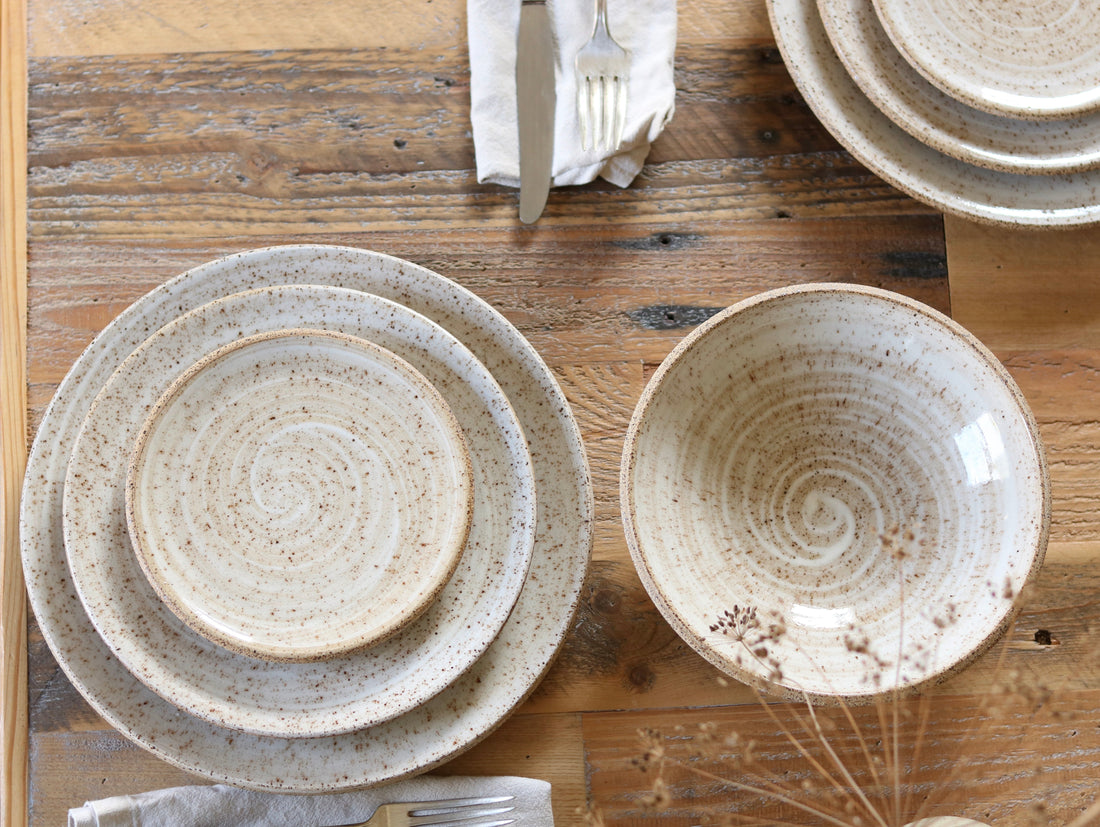
Considerations: Buying Handmade Dinnerware
Share
Handmade dinnerware can be so gratifying- it's an investment in our everyday ethos. It's the bowls you prepare summer salads in for the family, or the plate your reach for buttered toast and eggs in the morning. It can inspire and elevate our meals- and exists to hold nourishment, sustenance and the culture create behind this basic need. Wanting to celebrate this daily ritual with handmade pottery can stem from a desire to connect with our roots, with the humanity of feeding and taking care of ourselves and loved ones. But where do you start? What do you need to know before investing in pieces that should last a lifetime? Here are a few practical points to consider when purchasing handmade tableware.

Buying Locally
Look locally if possible - If you can find an artisan's work whom you admire and can visit their studio or examine the wares at a show- this is the best way to begin. The weight of a piece, the sheen and color and how these pieces can be imagined in your cabinet at home is easiest to gage in person! Being able to pick up your wares locally will also save you quite a bit on shipping, sets of dinnerware can be quite heavy and expensive to mail.
If you are coveting wares from a specific artist and buying online - this will open up a world (literally) of possibilities. Here are some specific things to consider when purchasing dinnerware.

Shape: How do they stack?
Buying a set is much different then buying a single stand alone piece. I would hope that the artisan has considered the pieces as a complete set. In terms of usability - plates and bowls should be able to stack in a way that makes reaching for them easy. This will enhance your experience with them and also mitigate the possibility of them breaking due to use. I look for a spacer between plates to make lifting them individually easy.

Additionally- to ensure that your pieces are as uniform as possible, while they will still embody the feeling and touches of handmade- try to purchase your wares in one order. If a potter makes your pieces individually on the wheel for example- they are measuring each one per order. When I made a set I will wheel throw a few extra to create the most coherent and beautiful set for the client. Adding to a set later means while I have my measurements, I am not able to see the full set together, so your pieces may have more of these slight differences in profile.

If you are selecting a colored glaze- know that colored glazes can be sensitive to minute changes in temperature which may occur kiln to kiln, or how the potter has mixed the glaze batch to batch.

If you need to break up your acquisition, consider buying a full set of dinner plates at one time, then coming back for a full set of bowls, say. This will help the potter make you the best set!
Shape: Plates- what to look for?
An ideal plate will dip very slightly in the center- this encourages sauces to come to the center of the dish. Certainly avoid dinnerware that may be lower on the outside areas of the piece.

The Glaze
In recent years and in fine dining, matte glazes have become extremely popular. The subtle softness they evoke is appealing and ethereal. I will however council you away from a matte glaze on table ware. The reason a matte glaze appears that way is that looking under a microscope- you would see a more craggy surface then you would with a gloss glaze. This uneven surface reflects light in a diffused way- but it is also more susceptible to scratching from regular cutlery use. I note on scratching in this way- while it appears that the pottery is scratched, most often it is that the pottery finish is in fact harder then the fork- so that the fork is leaving a mark. The good news is that this can be cleaned- look for bar keep or even magic easers have worked well for me. But better to avoid this issue altogether in my opinion, and this is why I offer only gloss glazed dinnerware.

Porosity of material
This tip is a bit technical - but you may want to consider asking your potter for the porosity of the clay they are using. Especially if they are recommending the pieces to be microwave and dishwasher safe. Porosity refers to how much water maybe absorbed if the piece is left in a basin. The issue becomes more apparent over time and will affect the durability of your wares. When a piece is highly porous (more then 3%, and hopefully less then 2%, the lower the better!) it will absorb water during the dishwashing cycle. The issue is when the dishwasher dries the wares at high temps- the water is being forced to expand and evaporate quickly, which over time is creating micro cracks in your wares, weakening them.

My stoneware is 1.7% porous - it has been tested for years in my home, and the quality with normal use (and kids) holds up. My porcelain peony dinnerware is rated at 2% absorption. Creating a ware which is strong as possible is part of the reason why this collection is fully glazed with the exception of the foot. Sealing the piece as fully as possible is a decision made for the durability of your wares.

You should not be shy about asking an artisan about porosity. It is common for a terracotta clay can have an absorption rate as high as 10%!
Whats your Sink?
Haha really, yes really- something I noticed when I moved from my apartment with a stainless steel sink, to my house where we have a porcelain sink is that all of a sudden we were breaking wares in the sink all the time which had never happened in my previous home. I realized after a month that this was due to the hardness of the commercially made porcelain sink. Pitting a handmade ware against a very high fired very hard porcelain sink is a recipe for frustration and tears as they are very unforgiving to seemingly normal use of putting dishes in the sink. They will slowly chip and crack away at the wares. Did I get a new sink? Well no, the good news is that If you have a porcelain or other commercially made ceramic sink- invest in a silicone mat for the bottom of the sink before your new pottery arrives! This absorbs the trauma those minor drops and shifts as dishes get piled in the sink. This may be a good little tip even for metal sinks. An extra cushion can't hurt.
Handmade pottery is a big decision, but it is exciting!

Handmade dinnerware can be a conversation starter- can add beauty and tone to the ritual of gathering, (or lets be honest cereal TV night). I hope that this short guide can help you make informed and confident decision around taking the leap into the diverse and colorful world of handmade dinnerware.
Visit available dinnerware from my shop above, and please don't hesitate to reach out with any questions about the wares or my pottery in general.
PS I am always happy to set up registries with items you are coveting! Just email me at twinettepoterie@gmail.com

